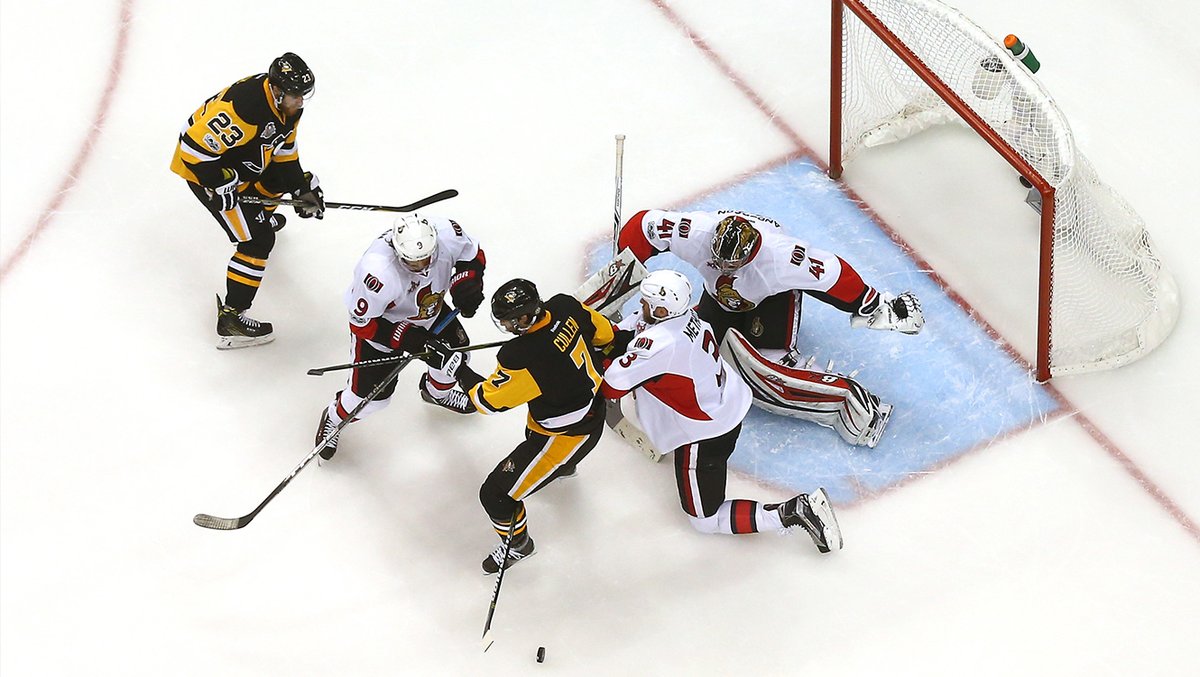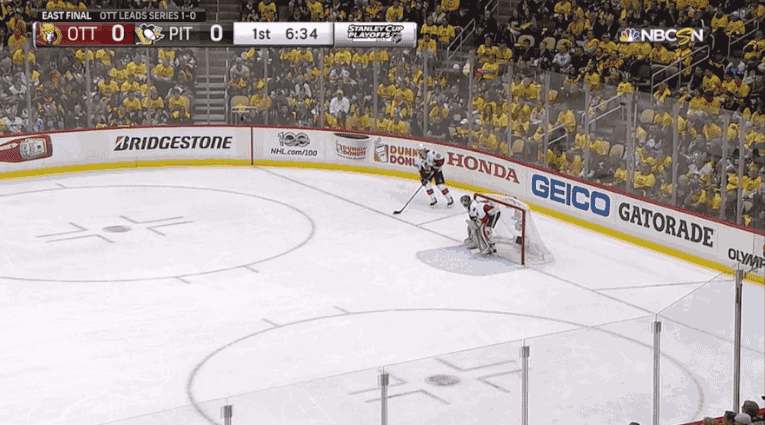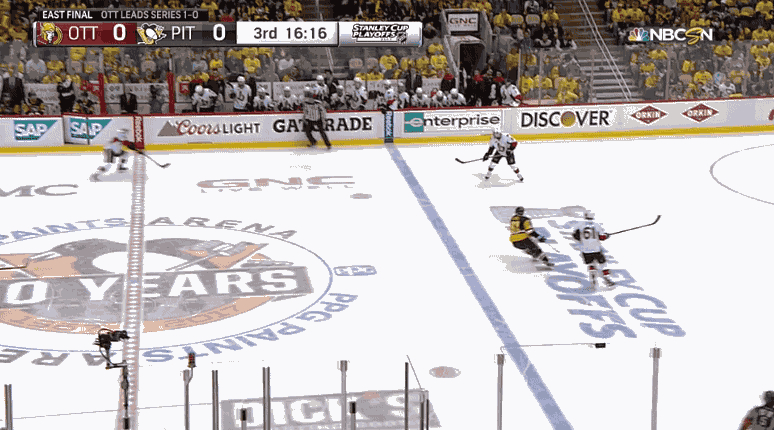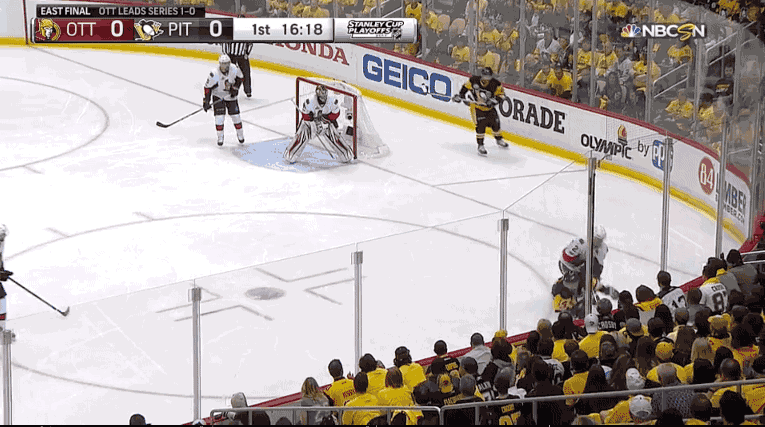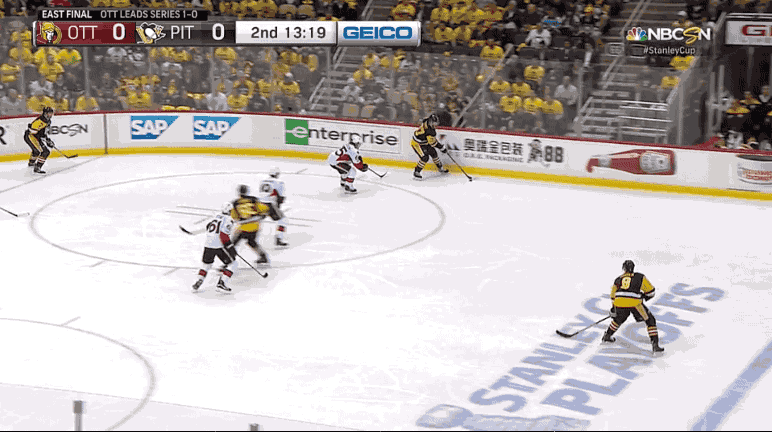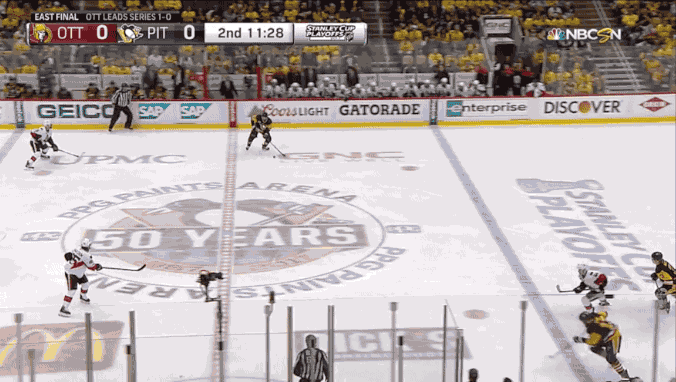If you’re a fan of end-to-end, free flowing hockey with two teams exchanging scoring chances while they race up and down the ice, this conference final between the Penguins and Senators ought to have your ripping your hair out of your head in frustration by now.
Give some credit to Guy Boucher and the Ottawa Senators on that front. Boucher, through the course of his professional career, has made the 1-3-1 his primary project, rarely deviating from this sludge-like approach to the game. The Senators behavior in the 1-3-1 is as habitual as waking up in the morning and they’re executing it at a consistently high level.
But having evened the series at one game a piece, some credit is due to the Penguins as well. Their game two performance was patient and relentless. That approach was reflected not only in video, but also in the overwhelming advantage they boasted in shot-attempts and scoring chances.
There’s nothing pretty about beating a team that clogs things up like the Senators. It’s not a work of art. Winning against a team playing this system this well often requires you to put on the work boots and take the ugliest approach to zone entries and shot-attempts that you possibly can.
The Penguins learned a few lessons from game one. Let’s take a look at a few strategies they’ve employed to break the vice of the Senators trap and create a little time and space from themselves in the neutral zone and the offensive zone.
What’s Good for the Goose…
Let’s not forget that the Penguins base structure in the neutral zone is a trap in and of itself. It’s not the boring, super-defensive version boasted by the Senators, but it’s still a trap in every sense of the word.
The primary focus of the Penguins version is to take away easy zone entries and generate odd-man rushes the other direction. The Penguins want to create turnovers that send their talented crop of forwards into the offensive zone with the opposing teams defense on its heels. We talked about this system and its specifics after the Penguins game seven win against the Washington Capitals.
One way to prevent the Senators from establishing themselves in a 1-3-1 structure is to prevent them from having the opportunity to do so. The Penguins have come out in their standard 1-2-2 trap and have forced Ottawa into turning the puck over quite a bit.
When you generate turnovers at either blueline, you’re flipping the play on its head and completely shifting the tide of the game. Defensemen that were in an attacking posture have to quickly re-adjust to a defending posture. The Penguins have been able to turn plays around and put the Senators defense on its heels while the forwards struggle to catch up and get involved in the play.
I’m a big believer that good defense begets good offense. The Senators can’t establish a stranglehold in the neutral zone if they’re on their heels because of a turnover. Let’s take a look at some examples from game two.
Here’s a great peek at Erik Karlsson getting fooled by the Penguins trap in at the onset of game two. Karlsson opts for a long breakout pass, but the Penguins are clogging all the lanes in the neutral zone.
The Penguins are able to steal this puck and cross the blueline with numbers while the Senators forwards are caught behind the play. The Senators have to quickly switch from offense to defense and they can’t keep a strong enough gap to prevent the Penguins from getting a good zone entry. You can see Jake Guentzel, the “1” at the top of the 1-2-2, pressuring Karlsson into making a pass that he isn’t 100% comfortable with.
Again, this speaks to getting the puck shifted up ice before the Senators have a chance to establish themselves in a 1-3-1 chokehold.
Here’s another great look at the Penguins structure. In this instance, the Senators take the middle lane and try to drive the puck wide into the offensive zone. The Penguins trap is designed to give skaters the guise that the middle of the ice is open. When that skater takes the middle of the ice, the back four in the 1-2-2 collapse on him and generate a turnover.
The Penguins break this puck out of the zone three skaters strong with the Senators defense stuck struggling to catch up. They keep a strong gap as Ottawa enters the zone and the 1-2-2 shifts to the puck side of the ice as the Penguins defense collapses on the puck-carrier.
This is the Penguins standard approach to neutral zone play. It’s one that can continuously garner turnovers that force the flow of the game to quickly shift in key areas of the ice. Expect to see more of the same as the series shifts to Ottawa.
Finding Spaces to Make Plays on the Puck
I don’t think enough gets made of the Senators structure once the puck enters their defensive zone.
While the 1-3-1 itself is certainly frustrating to play against, the Senators defensive structure is equally as maddening. If you think back to game one, it seemed like the Penguins had a good bit of zone time, but it didn’t result a lot of shot-attempts or scoring chances. Remember, heading into game two, taking more shots and generating more shooting lanes was a huge point of emphasis.
The Senators employ a Low Zone Collapse in the defensive end once their opponent establishes possession in their zone. This is a system that can give a team fits and create the guise that the five man defensive unit of the Senators is everywhere at once.
A Low Zone Collapse sees the defending team collapse in tight on their own goal and try to play the opposing team five on three down low, making it difficult for the attacking team to get pucks at the net, generate lanes, and out-man the defense in key battle areas of the ice.
Although the system is designed to flood the areas below the circles, it also places a premium on the F2 and F3 attacking the point as soon as the puck is moved high. Two forwards will generally rush the point when the puck moves there, attempting to make the defensemen uncomfortable and either generate turnover, or force the puck back down low where they collapse and start the whole vicious cycle all over again.
The good news for the Penguins that it’s impossible for a team to be everywhere at once no matter how much they give you that impression. Since the Senators are attacking low to high, there’s space that inherently opens up in the middle of the ice during those transitions and the Penguins have started to expose it a bit.
Remember, the Senators flood the bottom, but release two forwards to attack the point when the puck is worked high. That low-to-high movement is the key. Because the Senators are releasing their F2/F3 to attack high, the middle of the ice opens up and you can sneak a player in there to garner a shot-attempt from a high danger area. If you don’t utilize puck movement, you’ll just end up on the perimeter in disadvantageous situations the entire time, much like the Penguins did in game one.
Let’s take a look at some instances in game two where the Penguins were able to employ this strategy.
Here’s a great scoring chance from early in the first period of game two. The Penguins are cycling the puck down low. They’re rotating their forwards from the corner of the offensive zone, through the middle of the ice, and back again. That rotating movement is what creates this chance. Evgeni Malkin circles to the high part of the offensive zone and then attacks straight down the middle of the Senators collapse. Take a look at Kunitz here. He cycles around to follow the same path that Malkin took just a second earlier. This is a great forward rotation that consistently creates a bit of chaos in the middle of the ice.
As you can see in the clip, the middle of the ice is completely exposed here. Malkin attacks it and garners a quality scoring chance early in the game by finding that one area of the ice the Senators don’t have coverage on.
Here’s another great example of this middle ice strategy.
In the above clip, the puck is worked to the point. Take a look at the F2 and F3 of the Senators They immediately attack the top side of the ice to disrupt the Penguins at the top of the offensive zone.
Ron Hainsey and Carter Rowney have switched places during this cycle. Hainsey settles into a soft spot in the middle of the ice. The Senators have two forwards attacking the point, two defenders engaged down low, and the F1 can’t keep track of Hainsey as he sneaks into a scoring area in the slot.
This is a prime example of how low-to-high movement can generate open areas in the middle of the ice. The Penguins sneak an unmarked defenseman into the slot after creating some deception via the movement of their cycle and generate a solid scoring chance. This is the kind of patient approach you have to take against this system. It’s akin to cracking a safe.
While low-to-high movement accomplishes a goal in and of itself, lateral movement along the blueline can also achieve the same result.
The Senators want to outnumber you in wall battles and key areas of the ice. Remember, the goal of the Low Zone Collapse is to create a 5 on 3 situation down low.
Because the Senators will flood the puck side of the ice, working the puck laterally can also aid in finding key scoring areas of the ice. In this clip, the Penguins flood the near boards on their zone entry. Every forward is heading to the near side.
The lateral movement of Matt Cullen draws all the Senators to the near wall while Olli Maatta heads into the zone uncontested. He walks the puck in and generates a great shot-attempt from the top of the circle as a result.
At the end of the day, this is an arduous approach to generating offense. Even if you gain a good zone entry from the Senators 1-3-1, you still have a mountain of work in front of you to generate offense in the offensive zone. The good news is that the results from game two tell us the Penguins are well on their way to figuring it out.
It might not be fun to watch, it might be frustrating and slow, but if the Penguins stay persistent and patient, they’ll continue to make this a series of lopsided hockey games that feature the Senators hanging on for dear life for most of the contest. I don’t know about you, but I like their odds in that situation.
Add The Sports Daily to your Google News Feed!
